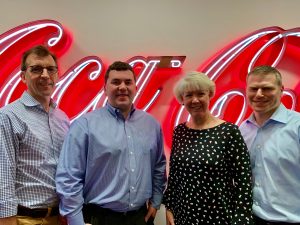
Optimising cash forecasting

Like joint award-winner Pearson, Coca-Cola’s award acknowledges it breaking new ground in one of the key treasury disciplines – cash forecasting.
Coca Cola epitomises a successful consumer goods company. Last year total cash flow from its global operations, which sell over 500 brands of soft drink in more than 200 countries, was $7.3 billion. Full-year revenues were $31.9 billion.
Such size and complexity would challenge any treasury team. The company’s breakthrough was to rethink both the technology and processes it used to produce its forecasts for both local and global cash flow.
In less than a year it shifted from a clunky legacy set-up – a broken global forecasting process, unwieldy Excel workbooks, and an ERP system with minimal capacity for ‘push button’ reporting and analytics – to a cutting-edge cash planning and business intelligence tool.
The new approach uses Oracle’s Hyperion Cash Flow Forecasting module to provide the environment for forecast submissions by Coke’s 50 largest legal entities. These account for some 95% of its global cash flow; they also include the company’s most cash-constrained units. Forecasts for the remainder are generated by algorithm.
To gain the analytics it was seeking, the treasury team applied Microsoft PowerBI to the cash/cashflow data in Hyperion. “BI has given Coke’s leadership team simple push-button access to critical cash/cash flow insights that we could have only imagined less than a year ago. We get significantly better insights with less overall effort,” comments Jim Aschmeyer, Director of International Treasury.
Large-scale company initiatives, such as one on working capital improvements highlighted by CFO John Murphy at Barclays’ recent Global Consumer Staples Brokers Conference, have also benefited, Aschmeyer notes.
Leading-edge capability
The analytics dashboard provides a granular perspective that encompasses cash flow forecasts, ending cash balances (both by liquidity type and location), inter-company cash flows, and working capital analytics. All can be viewed for the entire group, or specific operating areas or local businesses.
Since all transactions are entered in local currency and the tool also carries Coke’s currency forecasts, it also enables FX-adjusted cash flow forecasts.
Taken together, the system has taken the company’s cash flow forecasting “to the next level,” says David Wattenmaker – the International Treasury lead responsible for the project’s Analytics portion.
“The strategic planning we perform spans multiple years, making the need for a quality current-year baseline forecast all the more critical.”
“I’ve been looking for ways to get a useful cash flow forecast for years – we have made a significant step forward,” adds Kelly Angelo, Wattenmaker’s counterpart for Hyperion.
Besides a host of treasury professionals, users of the tool include Corporate Controllers, Investor Relations, Mergers & Acquisitions, Corporate Tax, and an increasing number of Operating Group CFOs.
25 ‘micro-challenges’
The project was far from straightforward. At its outset the Coca-Cola team broke it down into as many as 25 ‘micro-challenges’.
Together these seemed insurmountable. But collaboration between treasury and the finance IT areas – each assigning three staff to the project, plus a couple of recent graduates from Coke’s Finance Leadership Associates (FLA) programme – overcame each in about a year.

“The complexity of forecasting cash flow at the individual entity/country level was challenging. However, through an agile and collaborative process the Coca-Cola treasury team achieved a sustainable solution,” notes Wesley Cooler, Finance Leadership Associate.
No external consultants worked on the project. “We knew that we needed to own this one from all angles – it was simply too complex and time-sensitive to put consultants in the middle of,” Aschmeyer says.
The major challenges included expanding the scope of cash forecasting to also include short-term investments and marketable securities. Coke was determined to factor these in to create an overview of expected total financial resources at each entity. This would be more useful for overall liquidity planning and management, it judged.
This illustrates a broader challenge of the project: bridging GAAP and the definitions most useful to treasury.
Big benefits
The blue-chip has already achieved new visibility of several hundred million US dollars in cash as a result of its new tool, it estimates. Some $10 million in additional net interest earned highlights the optimised approach to cash management that the tool enables.
“Any time local business managers, global planners, and senior leadership can view the same business intelligence and focus on improving the same key drivers, value creation and speed can be enabled,” Wattenmaker adds.
Specific benefits Coke has achieved include avoiding capital contributions in two countries. These would have led to it run excess cash balances in each, but the tool allowed it to plan its cash more efficiently.
In addition, it was able to accelerate its dividend distribution from a subsidiary as it could reliably anticipate a higher cash balance there. Moreover, it was able to pay down expensive borrowings by the subsidiary.
Elsewhere, a robust forecast of larger balances also enabled it to accelerate cash remittances.
The initiative also provides significant time savings – both in liberating the international treasury team from around 40 hours of labour each month and in accelerating its provision of detailed cash flow data to senior management (now available in three days, versus two weeks previously).
Moreover, further benefits are very likely to be harvested in future, Coke judges.
Bottom-up
The tool enables Coke to take a rigorously bottom-up approach to cash flow forecasting, in contrast to the top-down firm-wide view that many peers settle for.
The company recently presented it to some 20 fellow multinationals at a peer network group. None had similar capabilities; many requested that the company share the knowledge it has gained from building the new tool.
Hear more from Coca-Cola and all our other EuroFinance Award Winners at International Treasury Management in Copenhagen
